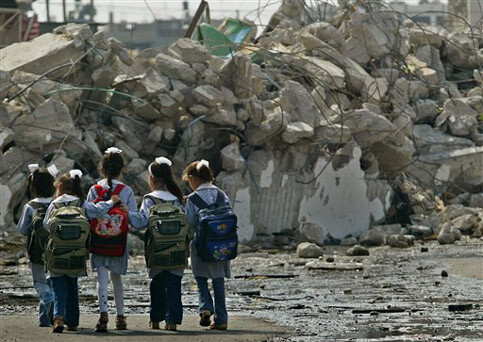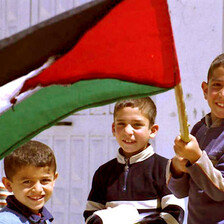
Four Palestinian girls on their way to school passing wide spread destruction in Jabalia refugee camp. (PCHR)
With his thumb held high and a broad smile, the school bus driver welcomes Tamer who proudly carries his little schoolbag on his back. He takes the seat right behind the driver so as to be able to peep over his shoulder towards the road. Watching this is one of those little every day rituals that keep Mary and me in a better mood than the situation otherwise would allow for.
Wearing her chequered school uniform, Jara too takes the school bus but unlike Tamer she is not always in her best mood. Her bag is stuffed with books and she curves her back to carry the burden. My Arabic teacher once said that it happens that Palestinian schoolbags are sometimes heavier than the children themselves, especially those small, fragile girls of Jara’s age. Every few days or so Jara has an imtihaan [exam], as it is called in class. At the beginning of the school year she was quite upset about them.
“Why are you so afraid about the exams,” Mary asks, “You were not afraid during the curfews, why should you be afraid now?” “Is 9,5 over 10 a good mark?”, Jara asks back, uncertain. The children in her class – second elementary; that is, six to seven years – compare their marks and of course the parents compare, too.
Yesterday Jara showed a table in which she assigned to each of the girls in her class an imaginary number supposedly matching their school achievements. It was a game the girls played among themselves. “Why do we need marks like 9,5 or 8,6 for children of seven years old?” Mary asks in exasperation.
The Palestinian curriculum is not easy, teachers and parents agree. The methods are definitely livelier than the pure rote learning of the past but the curriculum is simply a lot, a lot of materials, a lot to be memorized.
Suzy, an experienced teacher, sighs how it is possible that the curriculum developers were able to design such a sizable Arabic language method for the third elementary – “you need much more time than you have!” My Arabic teacher: “In the past you could elaborate upon the books; you were a story teller, you could go deep into the material out of your own experience. Now teaching becomes shallow.”
Jara does not have a light schedule either, with seven or eight different subjects a day (including Arabic, English and French - the Arabic and English being obligatory for all Palestinian schools from first grade elementary on). She also has different teachers for those subjects, and not to forget 40 pupils in class.
Each day Mary works with her for an hour or so to prepare homework for next day. It is the mothers who are helping the children, which is a part-time job especially when they have several young children up until 10 or 11 years who are not yet able to work alone. And if the mothers don’t have time, or are working or are not interested, the school kids face a comparative disadvantage which may well grow over the years.
Palestinian society puts much emphasis upon formal education as a way to get out of the difficult situation people live in. But it is also true that there is not a lot of time for other things — mainly playing, extracurricular learning, and fieldtrips, if possible at all.
Mary is rehearsing homework with Jara. I am more than a little curious when she is memorizing the names of refugee camps located in Jordan, West Bank, Gaza, Lebanon and Syria.
In general, as a parent I am happy with the way how politics is treated in Jara’s Arabic language lessons, which I follow myself too. Mostly they are about animals and fairytale-like stories but here and there a credible political story from daily life pops up, such as a mother and child who go to an Israeli prison, wait there for four hours in front of the gate but then are obliged to return without being able to visit the father.
Whatever Sharon may say (recently he called the Palestinian Authority to stop the “incitement” in the textbooks as an Israeli precondition for cooperation in the Palestinian elections), this is a very true story which many families experience. Not including politics in the curriculum is not an option because then you relegate thought and talk about politics just to the street and to the home. On the other hand, too much politics obviously does not match the fantasy world of the kids.
So I enquire with Mary how the issue of the refugees is dealt with in Jara’s wataniyye [national education]. It turns out that the chapter defines Palestinian refugees as those “who were obliged to leave their homeland and want to return.”
“But is there not something about the who, the where and the why?” I ask. No, the rest of the chapter deals with names of camps and the numbers of camps, which need to be known by heart. It doesn’t deal with the refugees’ story.
Mary is filling in the blanks, and tells Jara about how at the time when Israel was established many Palestinians were driven out, how the refugees in ‘Azza camp opposite our house first lived in tents and now in much too crowded houses. Why the shop at the corner is called Jibreen, and the camp sometimes Beit Jibreen, as the inhabitants come from a place in Israel near Beit Shemesh which was called Beit Jibreen and which is now called Beit Guvrin.
I tell Jara how you can still see in kibbutz Beit Guvrin the ruins of the old Arab houses and that reportedly the old village school now serves as the local administration block. Are we feeding her with hate, denying the legitimacy of Israel, as Sharon would have it, an accusation we have heard not a few times? It doesn’t look like it; Jara is rather happy that she is finished with the wataniyye, as she already knew that Israel never was a great friend of the Palestinians, and wants quickly to shift to the fairy tales of Grimm before she gets asleep.
But my own curiosity has not dried up and I ask a well-known local social studies teacher to what extent the students get real information about significant events in the Palestinian narrative, like 1948 or massacres at Kafr Kassem in 1956 or Sabra and Shatila in 1982.
“No, there is in fact very little in the Palestinian curriculum about such events.” “Even not about Sharon’s role in Sabra and Shatila?” “No, as far as I remember, Sharon is not mentioned, and if Sabra and Shatila are mentioned it is in passing, not in a context of a Palestinian story of suffering and resistance.” He himself teaches students from 14 years on, but he says he knows from colleagues that at other grade levels the situation is similar.
“Any events that are incriminating for Israel, such as massacres, are barely treated or not at all. As far as national politics is concerned, you can say that Oslo receives due attention, but also that is at a superficial level.”
So what is the reason? He pinches and shakes my arm and says: “It’s the US and Israel which set the limits of the curriculum. In terms of power, we are nothing!” So it is up to the teachers and the parents to teach the rest? “Yes, exactly, I try by myself to teach a coherent national story.” He too is filling in the blanks. Fuad, at the institute, tells me to be cautious with the conclusions of one teacher, and first to check out with more.
So I enquire what a few other teachers think, and I hear similar things. An UNRWA headmaster says that apparently under financial pressure of the American Congress some textbooks in wataniyye were withdrawn by UNRWA and that also military persons in Palestinian history like Abdel Qader al-Husseini (the Arab leader in the war of 1948) and ‘Ezzedine al-Qassem (a leader in the Palestinian insurgence from 1936-39) are not dealt with anymore in the books. Is it because al-Qassem is also the name of the rocket from Gaza and because the military unit of Hamas is called ‘Ezzedine al-Qassem? It seems.
Mary, in reaction: “But that’s incredible. After all, when the children grow up, they hear about such persons through other sources. Why should we hide ourselves from our own history?”
I still have this image engraved in my mind’s eye about a tender, fragile girl in school uniform, with her school bag on her back, who was half a year ago walking through Tantur, bypassing the main Bethlehem checkpoint. She waited for me so that I, a tall middle-aged foreigner, could accompany her to the other side, to her mother who was waiting there.
Another image: that of the 13-year lone Palestinian girl who was on her way to school in Rafah (Gaza Strip) on October 5, and who was shot down just like that. The army communications network tape showed that the soldiers involved “kept firing at the girl even after she had been identified by soldiers as ‘about 10 years old’.”
Palestinian hospital officials said the girl was shot at least 15 times, mostly in the upper body. Who is Sharon to teach Palestinians about incitement at schools when so many school children are afraid to go to school due to the checkpoint system and the occupation?
Tamer sits on his wooden mini-chair and solemnly reads from an adult book he borrowed from his father. The other day he was telling tete [grandmother] a story, “Kaan fi qadeem al-zamaan…” [Once upon a time….”]. When Mary stops in searching for the right name of the animal that fires the starting shot in the run between the rabbit and the turtle, he intervenes and says, “It’s the jaysh” [the army]. But he has limited time for reading or listening now he is able to navigate his three-wheel bicycle through the doors of our home.
“Tut-tut,” he shouts, and Mary sings with him “Tut-tut a Beirut” [tut-tut, up to Beirut], a song from Marcel Khalifeh. That’s it, we need horizon and curiosity, movement, also in learning, but lately Mary had frightening dreams about jungles and stumbling down. Today however she is excited to go with two colleagues to Ramallah now the checkpoint along theWadi Nar route around Jerusalem seems more passable than it used to be.
Jara wants to hide a treasure in the garden and looks for things to put in it. When I ask her what she likes most, she says “the witch.” She wants somebody to put things upside down for her. I read with her Grimm’s “The Musicians of Bremen,” about a walk of four animals who want to become town musicians in Bremen but never reach it, and give her the book as a treasure to put in her school bag.
Toine van Teeffelen is development director at the Arab Educational Institute (AEI) in Bethlehem and local coordinator of United Civilians for Peace.




